-
Countries
-
Data and Analysis
-
Special Focus
-
Crisis Responses
Baseline Assessment

Contact
DTM Sudan; dtmsudan@iom.int
Language
English
Location
Sudan
Period Covered
Apr 26 2024
May 08 2024
Activity
- Mobility Tracking
- Baseline Assessment
This report reflects data corresponding to Sudan Mobility Update (1) dataset. The dataset is available here.
Overview:
This report provides an overview of the total population of internally displaced persons (IDPs) in Sudan, including those displaced both before and after the onset of conflict on 15 April 2023.
The displacement crisis in Sudan has been unfolding for over two decades, with roots in the Darfur conflict beginning in 2003. Prior to the onset of conflict on 15 April 2023, Sudan already hosted an estimated 3,820,772 IDPs. The majority (80%) reportedly originated from Darfur states, and most were initially displaced between 2003 and 2010. Of these IDPs, many experienced secondary displacement after 15 April 2023. Since 15 April 2023, an estimated 7,111,788 individuals were displaced internally within Sudan — including those who experienced secondary displacement.
When accounting for those displaced both before and after 15 April 2023, DTM estimated that Sudan hosted a total of 9,957,655 IDPs.
Key Findings:
- An estimated total of 9,957,655 IDPs were displaced across 7,869 locations, in 183 localities in all 18 states in Sudan.
- An estimated 7,111,788 individuals were displaced internally within Sudan since 15 April 2023.
- An estimated 26 per cent of IDPs who were initially displaced prior to the onset of current conflict experienced secondary displacement since 15 April 2023.
- Approximately 2,111,791 individuals crossed borders into neighbouring countries since 15 April 2023.
- The top states of origin among IDPs were Khartoum (36%), South Darfur (21%), and North Darfur (12%).
- The states hosting the most IDPs were South Darfur (18%), North Darfur (13%) and Central Darfur (9%).
- Over half (56%) of IDPs were reportedly children under the age of 18-years-old.
Note: The number of IDPs displaced post 15 April 2023 (7,111,788 IDPs) includes the estimated 974,905 IDPs who were initially displaced prior to 15 April 2023 and experienced secondary displacement since 15 April 2023. DTM Sudan defines an internally displaced person as any person who has been forced or obliged to flee from their habitual residence due to an event dating from 2003 onwards.
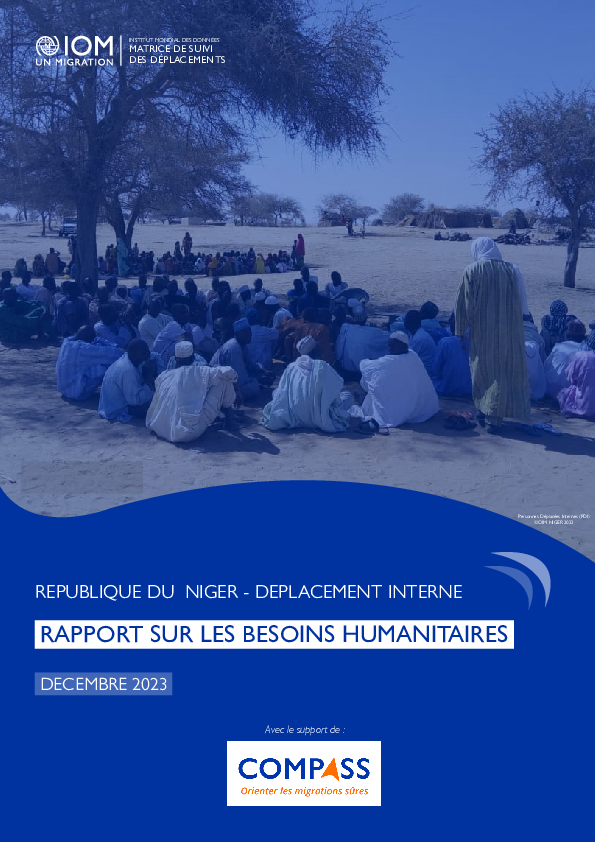
Contact
DTM Niger, DTMNiger@iom.int
Language
English
Location
Niger
Period Covered
Nov 17 2023
Dec 18 2023
Activity
- Mobility Tracking
- Baseline Assessment
Depuis 2014 le Niger est touché par de multiples crises sécuritaires ainsi que des catastrophes récurrents qui ont causé le déplacement de
centaines de milliers de personnes à l’intérieur du pays. Diffa, Maradi, Tahoua et Tillaberi sont les régions les plus touchées par ces phénomènes
(insécurité et catastrophe). Jusqu’en 2024, les attaques des groupes armés ont continué à pousser les populations à fuir leurs localités pour trouver
refuge dans des zones plus stables. À cela s’ajoutent aussi les catastrophes (inondations, pluies torrentielles, etc.) qui touchent les populations
chaque année.
L’Organisation internationale pour les migrations (OIM) au Niger a mis en oeuvre la Matrice de suivi des déplacements (Displacement Tracking
Matrix, DTM en anglais) en 2016 en étroite collaboration avec le gouvernement du Niger pour collecter et diffuser des informations régulièrement
sur la population mobile afin d’offrir au gouvernement et aux partenaires humanitaires une meilleure compréhension des mouvements de
populations et des besoins changeants sur les lieux de déplacement ou de transit au Niger. L’outil DTM comporte quatre (4) composantes: le
suivi des mouvements de population, le suivi des flux migratoires, les enregistrements et les enquêtes. Pour apporter son appui au gouvernement
et aux partenaires humanitaires afin de mieux comprendre les tendances de déplacement et la situation des déplacés, l’OIM en collaboration
avec le Ministère de l’Action Humanitaire et de la Gestion des Catastrophes (MAH/GC) a mis en oeuvre la composante suivi des mouvements
de population depuis 2019, appelée « Évaluation des Villages » (Village Assessment Survey (VAS), en anglais).

Contact
iomastana@iom.int iomalmaty@iom.int
Language
English
Location
Kazakhstan
Period Covered
Jan 01 2024
Jan 31 2024
Activity
- Survey
- Return Intention
- Mobility Tracking
- Baseline Assessment
The Mobility Tracking Matrix (MTM) is a system that tracks and monitors population mobility and displacement. MTM is adapted to the context in Kazakhstan based on IOM’s Global Displacement Tracking Matrix (DTM) methodology. DTM is designed to regularly and systematically capture, process, and disseminate information to provide a better understanding of the movements and evolving needs of mobile population groups, whether on-site or en route. MTM completed its first round of the Baseline Mobility Assessment (BMA) data collection on the district level in January 2023, the second round of BMA on the district level in May 2023, and the third round on the village level in December 2023. MTM enables IOM and its partners to maximize resources, set priorities, and deliver better-targeted, evidence-based, mobility-sensitive, and sustainable humanitarian and development programming.
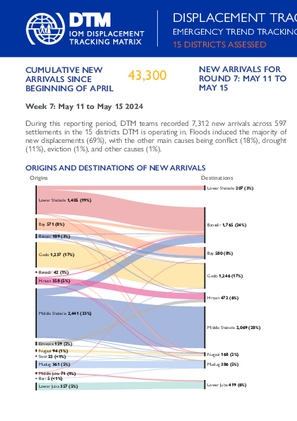
Contact
DTM Somalia, IOMSomaliaDTM@iom.int
Language
English
Location
Somalia
Period Covered
May 11 2024
May 15 2024
Activity
- Mobility Tracking
- Baseline Assessment
This latest round of Emergency Trends Tracking was initiated in April 2024 to monitor displacements movements during the Gu rainy season. Districts covered in this round include Afgooye, Afmadow, Baardheere, Baidoa, Balcad, Belet Weyne, Gaalkacyo, Garoowe, Jamaame, Jowhar, Kismaayo, and Luuq.
ETT is a crisis-based tool that tracks sudden displacement triggered by specific events or emerging crises. The objective of ETT is to help prioritize humanitarian response and to enable partners to deliver rapid assistance. Based on previous shock induced displacement patterns, the humanitarian community expects that people will continue to move toward urban areas in search of humanitarian services. Consequently, the ETT coverage focuses on the main urban centers and surrounding villages for each assessed district. The data is collected through Key Informant Interviews (KIIs) at the location level, from Sunday to Wednesday every week. It includes information on new arrivals, numbers and demographic of IDPs, reasons for displacement, intentions, humanitarian assistance and priority needs among others.
Contact
dtmuganda@iom.int vwabwire@iom.in
Location
Uganda
Activity
- Mobility Tracking
- Baseline Assessment
Period Covered
Apr 01 2024 -May 03 2024
In April 2024, the hazards affected 37,866 individuals (11,015 households), with 12,731 people from 3,717 households internally displaced due to the adverse weather conditions..
A more detailed version of this dataset, including the number of the vulnerabilities, is available. To get access, kindly click on the 'Request Access' button.
Population Groups
IDPs
Residents
Survey Methodology
Unit of Analysis Or Observation
Admin Area 2
Admin Area 3
Community
Type of Survey or Assessment
Key Informant
Keywords
Geographical Scope Full Coverage
Administrative boundaries with available data
The current dataset covers the following administrative boundaries

Contact
DTM Yemen, iomyemendtm@iom.int
Language
English
Location
Yemen
Period Covered
Jul 29 2023
Sep 20 2023
Activity
- Survey
- Mobility Tracking
- Baseline Assessment
This summary presents the findings of the second round of Area Assessment (mobility Tracking) undertaken by IOM’s Displacement Tracking Matrix in its new format to establish a new baseline on the number of Internally Displaced Persons (IDPs), IDP returnees, and migrants in Yemen.
Findings are currently limited to the country’s south controlled by the internationally recognized government (IRG). Data was collected by 154 enumerators through extensive network of Key Informants (KIs) within the operational area. DTM deployed enumerators who are in regular communication with the KIs network throughout each month and work continuously to maintain and expand this network to further triangulate the displacement statistics collected. DTM field staff, along with KIs, use the Sub-Area Assessment tool to capture locations, which are matched to identified locations in the OCHA’s Common Operational Dataset (P-Codes).
This round 4,512 KIs were interviewed to collect the data, of whom seven per cent or 295 were females and 93 per cent were male. In a total of 403 sub-districts, IOM recorded a presence of IDPs in 372 sub-districts (92%), a presence of IDP returnees in 209 sub-districts (52%) and a presence of migrants in 79 sub-districts (20%).
In the Yemen context, the practice for field teams is to select KIs representatives of both the host and target communities while adhering to the humanitarian principles of humanity, neutrality, impartiality, and operational independence. This ensures that the selected KIs are the most relevant and appropriate individuals to ensure the successful implementation of the exercise. Among the main outputs of the sub-Area Assessment is a list of locations where IDPs, returnees, and/or migrants are present that can be used to inform more detailed assessments at the locations level, including the annual Multi-Cluster Location Assessment (MCLA). Using a standardized and structured approach to the selection of KIs is a key step to ensuring that data collected in Sub-Area Assessment is comprehensive and comparable across the different teams. The Sub-Area Assessment tool is used to verify and update the baseline information in regular intervals (round).
IOM DTM implemented round 39 area assessment in coordination with the Ministry of Planning and International Cooperation Central (MoPIC), Statistical Organization (CSO), and Executive Unit for IDP Camps Management (ExU) in 13 governorates under the Government of Yemen. The number of migrants indicated in this report represents a snapshot in time for a transient population located in areas data collection teams could access.
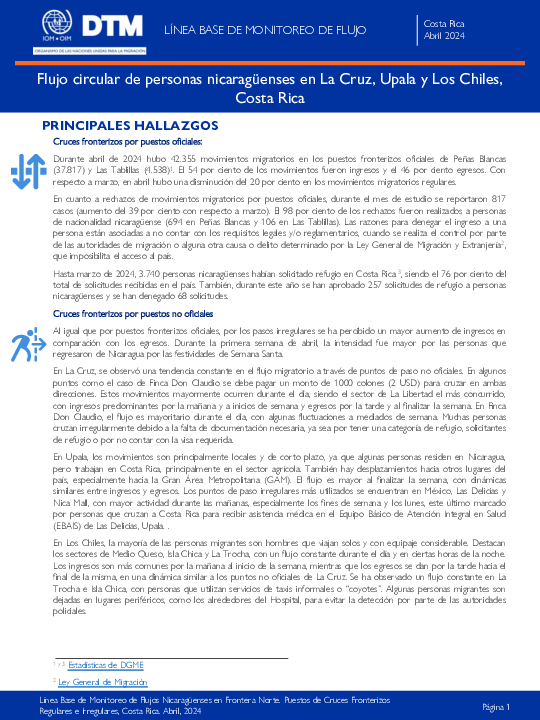
Contact
DTMCostaRica@iom.int
Language
English
Location
Costa Rica
Period Covered
Apr 01 2024
Apr 30 2024
Activity
- Flow Monitoring
- Baseline Assessment
La Organización Internacional para las Migraciones (OIM), como agencia de las Naciones Unidas en materia de migración en Costa Rica, implementó, desde 2021, dos rondas de la Matriz de Seguimiento al Desplazamiento (DTM por sus siglas en inglés) como parte de su estrategia de monitoreo del flujo migratorio circular de personas de nacionalidad nicaragüense, en puntos fronterizos no oficiales, en distintos cantones del norte del país. A partir de este ejercicio en tres puntos de ingreso no oficial de la frontera con Nicaragua, se contabilizaron 60 697 movimientos migratorios, de los cuales el 59 por ciento fueron egresos y 41 por ciento ingresos.
Siendo parte fundamental de la misión de OIM brindar asesoría clave sobre políticas y prácticas migratorias, se vuelve necesario actualizar los datos de este flujo migratorio circular de nicaragüenses que cruzan tanto de forma regular como irregular la frontera norte de Costa Rica.
Según los registros de la DGME de ingresos y egresos regulares por puestos fronterizos oficiales en Los Chiles y Peñas Blancas, en 2022 hubo 394.730 movimientos migratorios regulares (50 % ingresos y 50 % egresos) mientras que, durante el 2023, en total se registraron 526.271 movimientos migratorios (50 % ingresos y 50 % egresos), lo cual representó un aumento de 33 por ciento con respecto a 2022. Durante abril de 2024, se realizaron un total de 42.355 movimientos migratorios siendo el 54 por ciento egresos y el 46 por ciento egresos.
Contact
dtmlebanon@iom.int
Location
Lebanon
Activity
- Mobility Tracking
- Baseline Assessment
Period Covered
Oct 10 2023 -Mar 14 2024
Since October 8 there has been an increase in cross-border incidents between Israel and Lebanon, resulting in the displacement of people both within the South and elsewhere within the country. Since October 10, the Displacement Tracking Matrix (DTM) has been conducting the daily monitoring of population movements. The objective of the exercise is to inform preparedness and response planning.
Aggregated data is available through the DTM API: https://dtm.iom.int/data-and-analysis/dtm-api
A more detailed version of this dataset is available, to get access kindly click on the 'Request Access' button
Population Groups
IDPs
Survey Methodology
Unit of Analysis Or Observation
Admin Area 2
Admin Area 3
Household
Individual
Type of Survey or Assessment
Key Informant
Keywords
Geographical Scope Full Coverage
Administrative boundaries with available data
The current dataset covers the following administrative boundaries
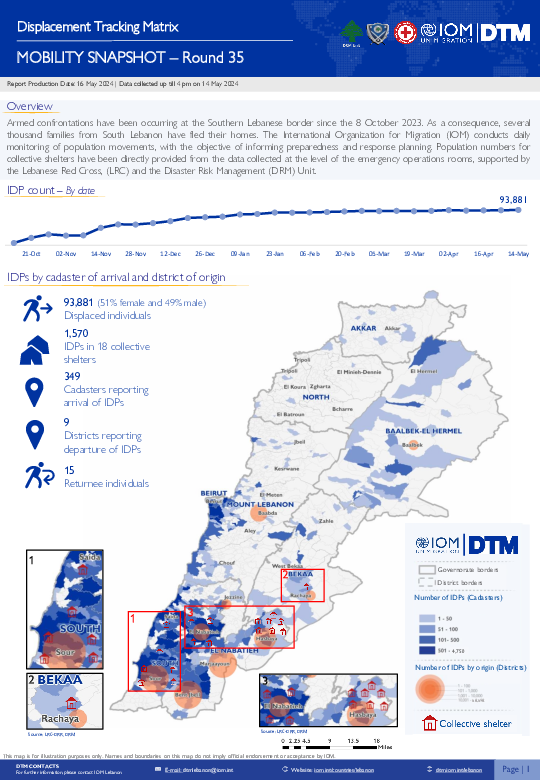
Contact
dtmlebanon@iom.int
Language
English
Location
Lebanon
Period Covered
Oct 10 2023
May 14 2024
Activity
- Mobility Tracking
- Baseline Assessment
Since October 8 there has been an increase in cross-border incidents between Israel and Lebanon, resulting in the displacement of people both within the South and elsewhere within the country. Since October 10, the Displacement Tracking Matrix (DTM) has been conducting the daily monitoring of population movements. The objective of the exercise is to inform preparedness and response planning.
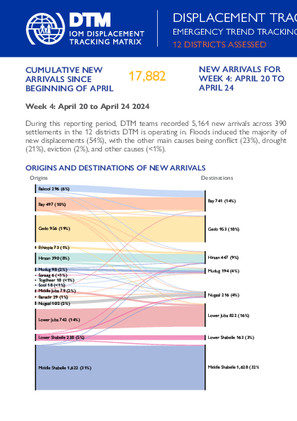
Contact
DTM Somalia, IOMSomaliaDTM@iom.int
Language
English
Location
Somalia
Period Covered
Apr 20 2024
Apr 24 2024
Activity
- Mobility Tracking
- Baseline Assessment
This latest round of Emergency Trends Tracking was initiated in April 2024 to monitor displacements movements during the Gu rainy season. Districts covered in this round include Afgooye, Afmadow, Baardheere, Baidoa, Balcad, Belet Weyne, Gaalkacyo, Garoowe, Jamaame, Jowhar, Kismaayo, and Luuq.
ETT is a crisis-based tool that tracks sudden displacement triggered by specific events or emerging crises. The objective of ETT is to help prioritize humanitarian response and to enable partners to deliver rapid assistance. Based on previous shock induced displacement patterns, the humanitarian community expects that people will continue to move toward urban areas in search of humanitarian services. Consequently, the ETT coverage focuses on the main urban centers and surrounding villages for each assessed district. The data is collected through Key Informant Interviews (KIIs) at the location level, from Sunday to Wednesday every week. It includes information on new arrivals, numbers and demographic of IDPs, reasons for displacement, intentions, humanitarian assistance and priority needs among others.
Pagination
- Previous page
- Page 27
- Next page
